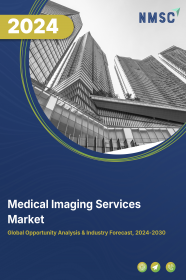
Medical Imaging Services Market by Procedures (X-ray, Computed Tomography (CT), Ultrasound Equipment, Magnetic Resonance Imaging (MRI), and Nuclear Imaging), by Application (Obstetrics/Gynaecology (OB/GYN), Orthopaedics, Neurology, Cardiology, Dentistry, Oncology, Mammography and Others), by End-user (Hospitals, Clinics, and Diagnostic Centres) - Global Opportunity Analysis and Industry Forecast 2024-2030
Market Definition
The global Medical Imaging Services Market size was valued at USD 624.81 billion in 2023 and is predicted to reach USD 933.30 billion by 2030 with a CAGR of 5.9% from 2024-2030. Medical imaging also known as diagnostic imaging, is a non-invasive medical procedure that uses electromagnetic radiation, ultrasound, and radio waves to produce images of internal structures of the human body.
The applications of medical imaging are diverse, spanning areas such as oncology, neurology, and cardiology, making it an indispensable tool in modern medicine. As a key component of healthcare systems, medical imaging plays a crucial role in disease diagnosis, management, and treatment planning.
Market Dynamics and Trends
A significant factor driving the growth of the medical imaging market is the rising prevalence of chronic diseases globally, including cancer, stroke, and heart diseases. These conditions require advanced imaging technologies for their accurate diagnosis and ongoing treatment monitoring.
This contributes to the expansion and development of the medical imaging market, as healthcare providers seek more effective ways to diagnose and monitor chronic conditions. According to the World Heart Report, more than half a billion people around the world continue to be affected by cardiovascular diseases, which accounted for 20.5 million deaths in 2021.
Moreover, the integration of artificial intelligence (AI) and machine learning (ML) in medical imaging is another pivotal growth driver. AI and ML enable faster, more accurate image analysis, enhancing both the efficiency and diagnostic capabilities of medical imaging.
However, the high cost associated with advanced medical imaging devices is posing a restrain in market growth. The purchase and maintenance of these machines require significant capital investment, which can be a barrier for healthcare facilities, especially in developing countries.
On the contrary, the ongoing advancements in imaging technologies, including 3D imaging and portable devices, open up new possibilities for enhanced diagnostics and patient care. These innovations can lead to more efficient, accurate, and patient-friendly imaging solutions, creating ample opportunities for market expansion in the future.
Market Segmentations and Scope of the Study
The medical imaging services market is segmented on the basis of procedures, application, end users and geography. Based on procedure, the market is divided into X-ray, computed tomography (CT), ultrasound equipment, MRI equipment, and nuclear imaging. X-ray is further sub-segmented into technology and portability.
Based on application, the market is classified into the obstetrics/gynaecology (OB/GYN), orthopaedics, neurology, cardiology, dentistry, oncology, mammography and others. Based on end user, the market is divided into hospitals, specialty clinics, diagnostic centers and others. Geographic breakdown and analysis of each of the aforesaid segments includes regions comprising North America, Europe, Asia-Pacific, and RoW.
Geographical Analysis
North America holds the major share of the medical imaging services market and is expected to continue its dominance during the forecast period. North America, particularly the United States, boasts a highly developed healthcare system with state-of-the-art medical facilities. This infrastructure supports the adoption and integration of advanced medical imaging devices.
Moreover, the region has one of the highest healthcare spending per capita in the world, allowing for significant investment in the latest medical imaging technologies. As reported by the Centers for Medicare & Medicaid Services, healthcare expenditure in the U.S. increased by 4.1% in 2022, totaling USD 4.5 trillion, which equates to USD 13,493 per individual.
Additionally, there is a high incidence of chronic diseases such as cancer, cardiovascular diseases, and neurological disorders in the region. Based on data from the National Center for Health Statistics, the United States witnessed 1,958,310 new cancer cases and 609,820 cancer-related deaths in the year 2023. These conditions necessitate frequent and advanced imaging for diagnosis and management, thus boosting the market in this region.
On the other hand, Asia Pacific is expected to witness a steady rise in the growth of the medical imaging services market driven primarily by its large and expanding population, coupled with a rapidly aging demographic. This shift towards an older population is leading to an increased need for medical imaging, as age-related health issues become more prevalent. As per the Economic and Social Commission for Asia and the Pacific, the region is home to 630 million individuals aged 60 and above, accounting for 60 percent of the world's elderly population, further underscoring the rising demand for medical imaging services.
Moreover, the Asia Pacific region is emerging as a leading center for medical tourism, drawing patients globally for a variety of medical treatments, including advanced imaging services. This growth is fueled by the region's rapidly expanding network of hospitals and the increasing popularity of medical tourism in countries such as Singapore, India, Malaysia, and South Korea.
These nations are renowned for offering high-quality medical procedures at reasonable costs, making them attractive destinations for international patients. Singapore, in particular, stands out due to its highly efficient healthcare system, which has been ranked among the top in Asia and sixth globally by the World Health Organization. This distinction positions Singapore as a key destination for cutting-edge medical tourism, significantly contributing to the expansion of the medical imaging services market in the Asia Pacific.
Competitive Landscape
Various market players operating in the medical imaging services industry include RadNet, Sonic Healthcare, Dignity Health, Novant Health, Life Healthcare Group, InHealth Group, Medica Group, Global Diagnostics, Healthcare Imaging Services Pty Ltd., and Concord Medical Services Holdings Limited. These market players are adopting various joint venture strategies and planning expansion of business across various regions through acquisitions to maintain their dominance in the medical imaging services market.
For instance, in November 2023, RadNet, Inc., a leading provider in the outpatient diagnostic imaging services sector, announced the introduction of DeepHealth, a state-of-the-art health informatics portfolio. This significant development is poised to greatly enhance efficiency and redefine the role of radiology within the broader medical imaging services industry.
Moreover, in August 2022, Life Healthcare has expanded its Southern African operations portfolio by acquiring the non-clinical imaging operations of Eugene Marais Radiology, situated at the Life Eugene Marais Hospital in Pretoria.
Key Benefits
-
The report provides quantitative analysis and estimations of the medical imaging services market from 2024 to 2030, which assists in identifying the prevailing market opportunities.
-
The study comprises a deep dive analysis of the current and future medical imaging services market trends to depict prevalent investment pockets in the industry.
-
Information related to key drivers, restraints, and opportunities and their impact on the medical imaging services market is provided in the report.
-
Competitive analysis of the key players, along with their market share is provided in the report.
-
SWOT analysis and Porters Five Forces model is elaborated in the study.
-
Value chain analysis in the market study provides a clear picture of the roles of stakeholders.
Medical Imaging Services Market Key Segments
By Procedures
-
X-ray
-
Computed Tomography (CT)
-
Ultrasound equipment
-
Magnetic Resonance Imaging (MRI)
-
Nuclear Medicine Imaging
By Application
-
Obstetrics/Gynecology (OB/GYN)
-
Orthopedics
-
Neurology
-
Cardiology
-
Dentistry
-
Oncology
-
Mammography
-
Others
By End User
-
Hospitals
-
Specialty Clinics
-
Diagnostic Centers
-
Others
By Geography
-
North America
-
The U.S.
-
Canada
-
Mexico
-
-
Europe
-
The U.K.
-
Germany
-
France
-
Italy
-
Spain
-
Denmark
-
Netherlands
-
Finland
-
Sweden
-
Norway
-
Russia
-
Rest of Europe
-
-
Asia-Pacific
-
China
-
Japan
-
India
-
South Korea
-
Australia
-
Indonesia
-
Singapore
-
Taiwan
-
Thailand
-
Rest of Asia-Pacific
-
-
Rest of the World (RoW)
-
Latin America
-
Middle East
-
Africa
-
Key Players
-
RadNet
-
Sonic Healthcare
-
Dignity Health
-
Novant Health
-
Life Healthcare Group
-
InHealth Group
-
Medica Group
-
Global Diagnostics
-
Healthcare Imaging Services Pty Ltd.
-
Concord Medical Services Holdings Limited
REPORT SCOPE AND SEGMENTATION:
|
Parameters |
Details |
|
Market Size in 2023 |
USD 624.81 Billion |
|
Revenue Forecast in 2030 |
USD 933.30 Billion |
|
Growth Rate |
CAGR of 5.9% from 2024 to 2030 |
|
Analysis Period |
2023–2030 |
|
Base Year Considered |
2023 |
|
Forecast Period |
2024–2030 |
|
Market Size Estimation |
Billion (USD) |
|
Growth Factors |
|
|
Countries Covered |
28 |
|
Companies Profiled |
10 |
|
Market Share |
Available for 10 companies |
|
Customization Scope |
Free customization (equivalent up to 80 working hours of analysts) after purchase. Addition or alteration to country, regional, and segment scope. |
|
Pricing and Purchase Options |
Avail customized purchase options to meet your exact research needs. |




















 Speak to Our Analyst
Speak to Our Analyst

























